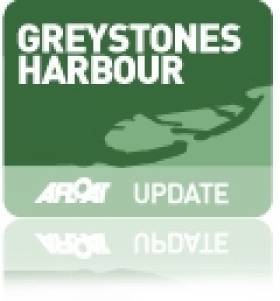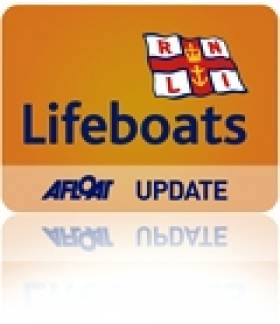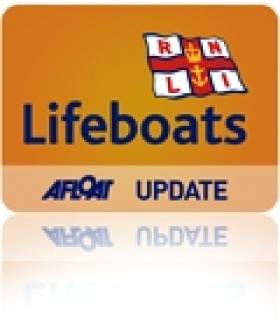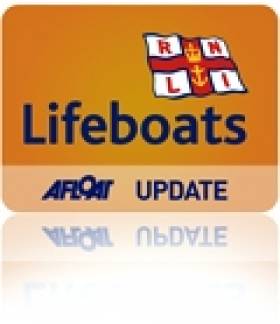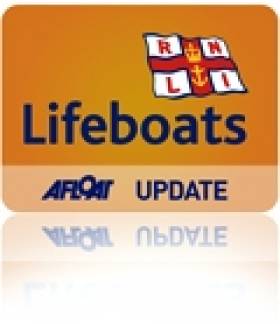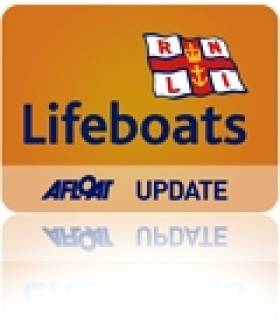Displaying items by tag: RNLI
Three Bodies Recovered in Shetlands Helicopter Crash
#RNLI - Three bodies have been recovered from the water after a helicopter with 18 people on board crashed in the North Sea last night (Friday 23 August).
RNLI lifeboats from Aith and Lerwick in the Shetland Isles have spent the night involved in a multi-agency rescue operation, following reports that a helicopter had ditched into the sea west of Sumburgh airport.
It's believed the helicopter, a Super Puma L2, was carrying 16 passengers and two crew from the Borgsten Dolphin oil platform in the North Sea.
Both volunteer lifeboat crews made their way to the scene throughout the evening and assisted in the search for passengers with other agencies, including two coastguard rescue helicopters, a passenger ferry and a cargo vessel.
Fourteen people were rescued while the lifeboats were still making their way to the scene.
But early this morning Police Scotland conformed that three bodies had been recovered, two of which were recovered by Lerwick RNLI lifeboat and taken to a nearby pier. Work is now underway to recover the fourth individual.
A spokesperson for the RNLI said: "Sadly the bodies of three people have been recovered in the aftermath of yesterday’s crash, and we know that agencies are working to recover the body of the fourth person.
"We can confirm that the RNLI lifeboat crew from Lerwick lifeboat station recovered two of those people. The lifeboat crew transported them to Sumburgh and we are liaising with other authorities as things develop.
"Obviously this is the news that everyone, included our lifeboat volunteers, dreaded – our thoughts and prayers are with the families and loved ones of those four people. We can also confirm that one of our lifeboats has also been involved in reclaiming wreckage from the scene as part of the operation."
The wreckage of the helicopter is in a fairly inaccessible position near cliffs, and weather conditions at the time were described as not particularly good.
Lerwick RNLI lifeboat managed to tow the wreckage off rocks and it was being held in the shelter of a bay until a recovery operation could commence.
Greystones Motor Yacht Club (GMYC) Hosts RNLI Evening
#Greystonesharbour – Greystones Motor Yacht Club will have an RNLI Lifeboat presentation night next Thursday 29th August at 8pm.
The venue is upstairs at the nearby Beach House Pub, next door to Greystones Harbour, a location popular with visiting sailors, including the Squib class.
Joe Taylor from the RNLI hopes to have the lifeboat 'Annie Blaker' in attendance at the harbour.
GMYC We is also going to launch the new Greystones Harbour defibrillator scheme with an explanation of how it will operate.
Lough Swilly RNLI Aids Fishermen Near Malin Head
#RNLI - Lough Swilly RNLI came to the aid of two fishermen yesterday (22 August) after their open boat was grounded on rocks near Malin Head, as the Irish Independent reports.
The Lough Swilly lifeboat was joined by the volunteer crew from Greencastle and the Sligo-based Irish Coast Guard rescue helicopter to attend the 22ft fishing boat. Both fishermen on board were recovered and are well.
It is not yet clear how the vessel came to crash on the rocks off Trawbrega Bay, with conditions in the area said to be "not bad". The Irish Independent has more on the story HERE.
Crosshaven RNLI Lifeboat Assists Five Teenagers in Yacht
Five young teenagers were assisted to safety this evening as they were transferring by dinghy from a Yacht to the shore and their engine failed.
With 6 knots of an ebbing tide running, the dingy was quickly swept down the East Ferry channel.
Other persons onboard the yacht alerted Valentia Coastguard to the plight of the teenagers and Crosshaven RNLI lifeboat launched at 9.58pm
with Alan Venner, Dan O'Donoghue and Ian O'Keefe on board to make the 6 mile crossing of Cork Harbour to East Ferry arriving on scene at 10.15pm.
On arrival, the motor vessel "Vixen" had responded, rescued and taken on board the persons adrift, The lifeboat stood by whilst "Vixen" put them ashore at Murphy's pier.
The crew made sure the occupants were in no need of medical help. It then became apparent that two adults and three further children were now marooned
on board their yacht with no tender and the 45' yacht had too deep a draught to come alongside. The lifeboat proceeded to the yacht, took off and landed
the remaining five persons at Murphy's pier.
The lifeboat then returned to the station, refuelled, washed down and was ready for service at 11.15pm
Lough Ree RNLI To Celebrate First Year of Service
#RNLI - Lough Ree RNLI is celebrating its first year in service and is holding an open day on Saturday 31 August for the public to come and see how the station operates.
The volunteer crew at the station will be on hand to meet and greet people as well as put on a display to show how the inshore lifeboat is launched, some of the exercises it carries out and how it is then recovered.
Lough Ree RNLI lifeboat station in Co Westmeath went into operation on a trial period in July last year and since then has been a busy station, with 14 call-outs in its first six months of operation and a further 24 shouts to date in 2013.
The call-outs have been varied from helping boats that have got into difficulty in rough weather, to helping vessels which have got lost while on the lake day and night, to a boat sinking rapidly after hitting hidden debris in the water.
All RNLI lifeboat stations are run on a volunteer basis and it is through the time and dedication shown by their volunteer crew members that they are able to provide communities, including Lough Ree's, with such a vital search and rescue service.
All at Lough Ree RNLI are looking forward to meeting visitors at the station in Coosan Point on Saturday 31 August between 2pm and 4pm.
Dun Laoghaire RNLI Lifeboat Medevac From Dublin Bay Cruise Liner
#rnli – Dun Laoghaire RNLI lifeboat carried out a medical evacuation to assist an elderly woman from a cruise ship after she became ill on the vessel which was located in Dublin Bay.The volunteer crew was requested to launch their all weather lifeboat, the Anna Livia, at approximately 10pm on Monday night last (19 August) following a report that an elderly woman was reported unwell on the cruise liner.
The crew under Coxswain Mark McGibney, made their way to the scene some four nautical miles away where Dr Sarah Brookes, Dun Laoghaire RNLI Deputy Lifeboat Medical Adviser was then put on board the cruiser and assessed the ill lady. The casualty was brought onboard the lifeboat on a stretcher and transferred to a waiting ambulance once ashore.
Wicklow RNLI Remembers Historical Greystones Lifesaver
#RNLI - Wicklow RNLI travelled to Greystones on Sunday afternoon (18 August) for the unveiling of a plaque in memory of RNLI coxswain John Doyle and two members of his family, who lost their lives in 1892.
The deceased were trying to assist a vessel breaking away from her moorings in Greystones Harbour on 14 October 1892, a Friday night when heavy seas and a north-east gale prevailed in the Irish Sea.
That night, the schooner Mersey, which was moored alongside the jetty at Greystones, threatened to break up where she lay, and the owner resolved to let her drive on the beach.
John Doyle and William Doyle - with Herbert Doyle, son of the latter - went out along the jetty to cast a rope to the vessel and, having done so, were making their return when a great wave suddenly engulfed them. They had often gone out to save life and were famed for their bravery.
John and William Doyle left large families, and there were many tearful eyes at the funeral service in St Patrick's Church for the three Doyles, many of whose descendants are still in Greystones.
The Anchor amusement centre and restaurant at the harbour was originally a lifeboat house, and between 1871 and 1896 there were two lifeboats, the Sarah Tancred and the Richard Brown, the latter of which John Doyle served as coxswain.
As the Wicklow lifeboat entered Greystones, the crew scattered flower petals inside the harbour entrance as a mark of respect for coxswain Doyle.
John Doyle’s granddaughter Betty Lowe unveiled the plaque on the pier wall. During the ceremony, the lifeboat crew presented her with a framed photograph of the Wicklow lifeboat and an RNLI flag.
Lowe was inspired to erect the memorial after attending the unveiling of The Beacon of Hope sculpture in 2009 at the RNLI headquarters in Poole. Her grandfather’s name is one of hundreds on the memorial who have given their lives selflessly to save others over the last 200 years.
Speaking after the ceremony, Wicklow RNLI volunteer lifeboat press officer Tommy Dover said: "We would like to thank Mrs Lowe and her family for inviting us to the ceremony, it was a great privilege to be involved."
Baltimore RNLI Inshore Lifeboat Bring Home Four People (& 2 Dogs!)
#rnli – The Baltimore RNLI inshore lifeboat went to the assistance of a motor cruiser whose engine failed near Horse Island in West Cork this afternoon Tuesday 20th August. The alarm was raised at 15:05 and within minutes the lifeboat was underway. Helm John Kearney and his crew proceeded through the islands of Roaring Water Bay to rendezvous with the stricken vessel which had subsequently anchored between Horse Island and Castle Island.The 6.5m day cruiser whose engine had overheated had a party of 2 men, 2 women and 2 dogs on board at the time and had been on passage from Baltimore to Schull. The lifeboat crew passed a tow to the vessel and took her in tow returning her to her moorings in Baltimore Harbour.
Helm John Kearney commended them for staying calm, he said 'They did everything right, they were wearing life jackets and anchored promptly to secure their safety when her engines failed'.
Helm John Kearney, crew Ger O"Brien and Peter Losberg. Slip crew John O'Flynn, Colin Rochford and Declan Tiernan.
#RNLI - Some 46 people completed the 750m course on Lough Erne in the revived Castle Island Charity Swim recently - including three Enniskillen RNLI lifeboat crew in full kit!
As reported last month on Afloat.ie, the swim traditionally took place annually with the support of the Blake family, and Enniskillen RNLI hailed as a "great honour" the chance to bring back the annual event.
Apart from the action on the water on Sunday 11 August, the day featured was a family fun morning on shore with a bouncy castle, face painting and an ice cream stand.
Lifeboat volunteer crewman Adrian Kelly said of the day: "I would like to take this opportunity to thank everyone who got involved on all levels. I really hope everyone enjoyed the event and that we can give it a go next year."
Video: Bangor RNLI In Canoe Rescue
#RNLI - The RNLI has posted video to YouTube of the Bangor lifeboat crew's rescue of two canoeists from the water at Belfast Lough last Monday 12 August.
The two paddlers were reported to be suffering from the cold and exhaustion but were taken to safety by the Bangor RNLI volunteers.


























